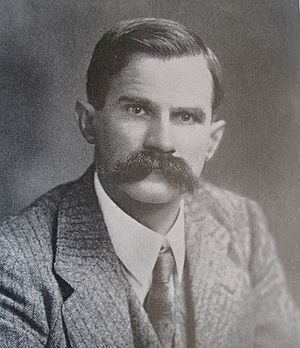William Wilson (English academic) facts for kids
Quick facts for kids
William Wilson
|
|
|---|---|

William Wilson
|
|
| Born | 1 March 1875 Goodyhills, Cumberland
|
| Died | 14 October 1965 (aged 90) |
| Alma mater | Aspatria Agricultural College |
| Awards | Fellow of the Royal Society |
| Scientific career | |
| Institutions |
|
William Wilson (born March 1, 1875 – died October 14, 1965) was a very important scientist and teacher. He was born in Goodyhills, a small place in the Cumberland area of England.
He went to school in his village and later studied at Aspatria Agricultural College. William Wilson became a Fellow of the Royal Society, which is a big honor for scientists. He made important discoveries in physics, especially about how light and tiny particles behave.
Contents
William Wilson's Early Life
William Wilson was born in Goodyhills, Cumberland, in 1875. He was the oldest of eleven children in his family. His parents were William Osmotherley Wilson and Isabella.
William started school at the village school in Holme St Cuthbert. He was a very bright student and did extremely well. His teacher, John Routlege, saw his talent.
How William Got His Scholarship
Because he was so good at school, William won a special scholarship worth £25. This scholarship allowed him to go to Aspatria Agricultural College when he was just fourteen years old.
Studying at Aspatria Agricultural College
William Wilson studied at Aspatria Agricultural College from 1891 to 1893. His main teacher there was Henry J. Webb. He learned many different subjects.
Awards and Achievements at College
In 1891, William earned a high-level certificate in many subjects. These included botany (the study of plants), mechanics (how things move), physiology (how living things work), and advanced chemistry. He also studied drawing and mathematics.
In 1892, he received a special Diploma and became a lifetime member of the Royal Highland and Agricultural Society of Scotland. This was a big achievement for someone studying agriculture.
Inside the college, William won first prizes for chemistry, mathematics, and animal philosophy. He also earned special certificates for physiology, botany, and zoology (the study of animals). He won the Principal's prize for getting the highest total scores in these exams.
In his last year, he did very well in the exams for the Royal Agricultural Society of England. He finished in ninth place and earned a first-class certificate. He also became a lifetime member of this society.
Moving On to Higher Education
After leaving Aspatria in 1893, William received another scholarship. This one was worth £80 and allowed him to study at the Royal College of Science in South Kensington. There, he focused on agriculture and agricultural chemistry.
William Wilson's Career and Discoveries
After his studies, William Wilson started his working life. From 1896 to 1898, he taught at a school in Towcester, England. In 1898, he became a mathematics teacher at two other colleges in England.
Studying in Germany
William wanted to learn even more about mathematics. So, he decided to learn German. This skill helped him teach at the Berlitz Language Schools in Germany from 1901 to 1902. He taught in several German cities like Elberfeld and Cologne.
In 1902, he became a student at Leipzig University in Germany. There, he earned his PhD degree. His research was about the photoelectric effect. This is a science idea about how light can make electrons move. While he was in Germany, he met Rose Heathfield, who later became his wife in 1909.
Teaching and Research in London
When William returned to England in 1906, he became an assistant lecturer at King's College London. He worked in the Wheatstone laboratory. During his time there, he studied how hot objects give off tiny particles of light called photons.
He was also very interested in big ideas like the theory of relativity and quantum theory. These theories explain how the universe works at a very small level. William understood the important ideas that Niels Bohr introduced in quantum theory.
He also helped explain how electrons move around the center of an atom in what are called atomic orbits. He even used a special version of Bohr's ideas to figure out the shape of these orbits.
In 1917, he earned another doctorate degree from London University. In 1919, he became a Reader in the Physics Department at King's College. Then, in 1921, he became a professor of physics at Bedford College. He worked there until he retired in 1944.
Honors and Retirement
William Wilson received many honors for his work. In 1923, he became a Fellow of the Royal Society. This is one of the highest honors for scientists in the United Kingdom. He also became a Fellow of King's College London. When he retired in 1944, he was given the title of Professor Emeritus.
William Wilson's Later Years and Death
William Wilson passed away in 1965 at his home in Hereford. His son, W.F.H.F. Wilson, worked as a lawyer in Hereford.
Books Written by William Wilson
William Wilson wrote many articles and papers during his life. He also had at least four books published. Some of his book titles include:
- A Hundred Years of Physics, published in London in 1950.
- Theoretical Physics, which came out in three volumes between 1931 and 1940.
- The Microphysical World, published in London in 1951.
- Nuclear Physics, which was a translated book he worked on, published in 1953.

